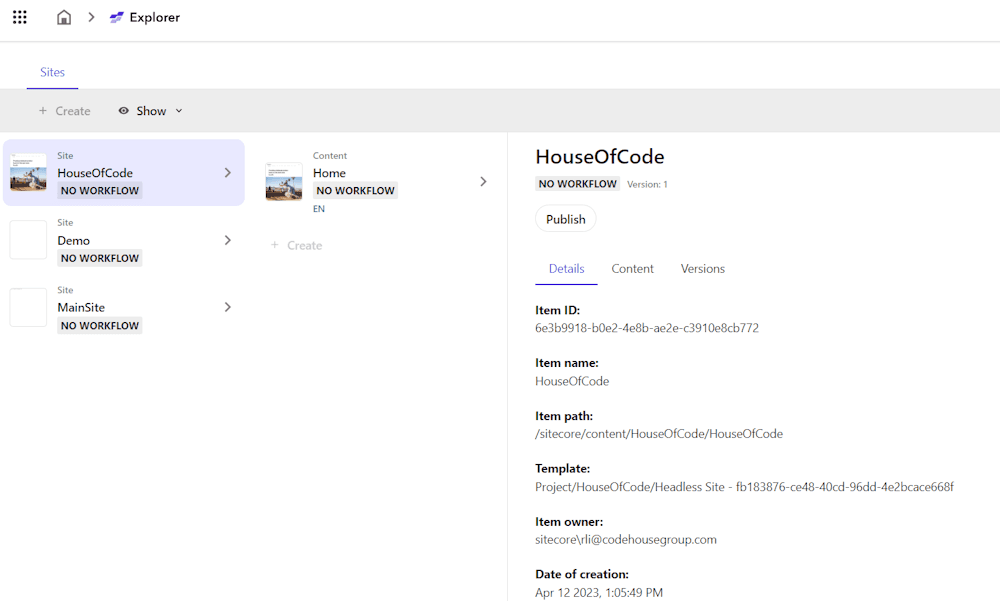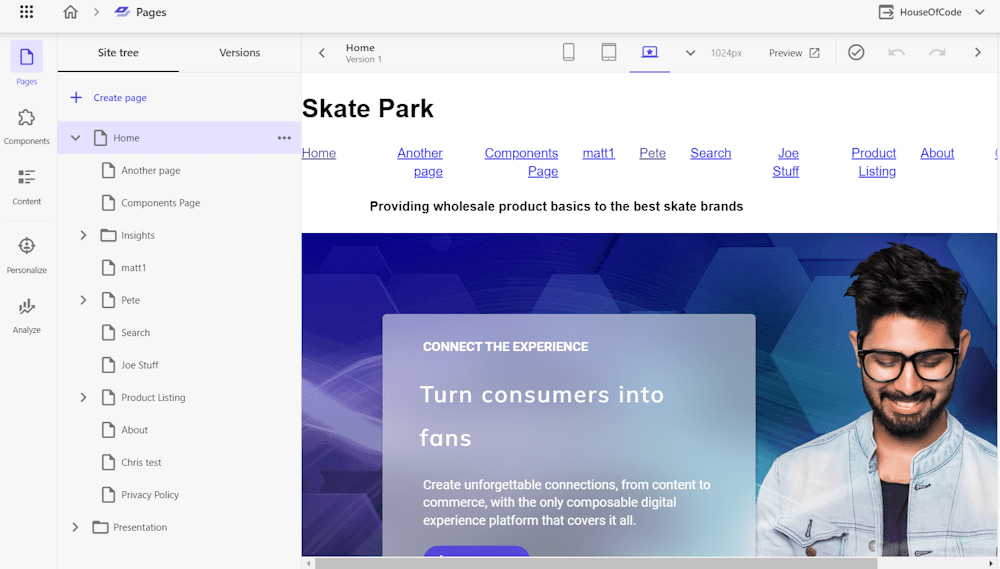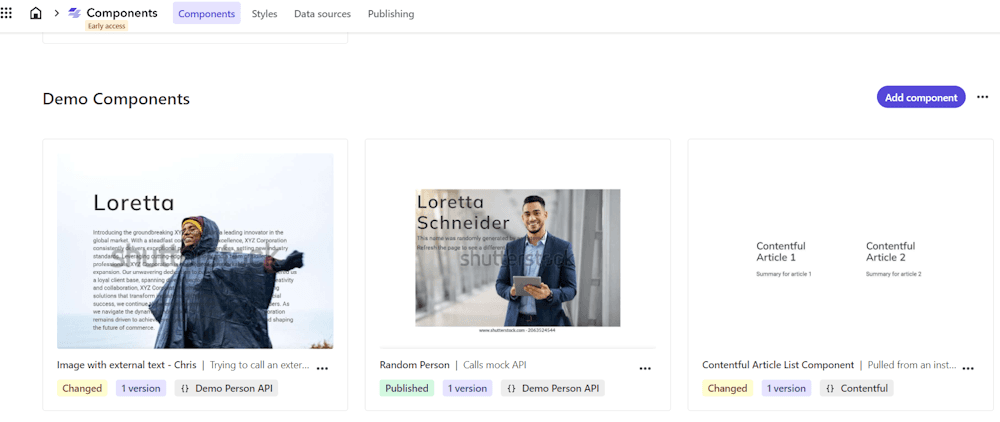Jul 4, 2023
Technology
4
min read

Peter Lambrou
,
Sitecore Optimisation Consultant MVP Strategist
Our experiences determine whether we'll return to the shop or website. But experience also extends to a business perspective. In other words, the experience of operationally running your technology stack and the total cost of ownership (TCO).
That's where Sitecore's XM Cloud comes in. From configuration to design and build, XM Cloud will save you money compared with the more traditional options. But how and by how much? Let's start with a quick snapshot of XM Cloud.
Snapshot of Sitecore XM Cloud
Derived from Experience Manager, XM Cloud, launched in 2022, is a Software-as-a-Service (SaaS) cloud-based headless digital experience platform.
Part of Sitecore’s Content Cloud composable architecture, XM Cloud has powerful multi-channel marketing capabilities, composability and scalability. It enables content editors to easily create memorable content for their digital market in super-fast time.
Plus, developers can work in an agile low-code/no-code environment. This allows them to build websites with modern frameworks and simplified DevOps easier and quicker than in a non-cloud-based setup.
XM Cloud has three key features, each designed to make life so much easier for its users.
Explorer: A streamlined management tool that allows you to control all your websites in one place.

Pages: Perfect for content creators and marketers. It brings together templates, components, content, and media so that perfect experiences can be crafted.

Components: Native to Pages, developers and content creators can build reusable components.

Now that we've highlighted what XM Cloud is, let's address some of the cost saving benefits it can bring to your business.
Digital modernisation and reinvention
Surveys by Accenture and The Everest Group highlight the impacts on business growth when modernising digital assets.
Accenture found that “companies that pursue Total Enterprise Reinvention are nearly 2x more likely to have been—or expect to be—highly successful in delivering on their business case than Transformers, and 8x more likely than Optimizers.”
The Everest Group stated that “90% of businesses believe legacy and monolithic systems hinder business growth.”
Investing in new solutions is a significant step. When it comes to ROI and TCO, transitioning from monolithic to composable technology is the way to go. Composable tech is now at the forefront of experiential systems.
The cloud nativity of XM Cloud creates a seamless flow across all channels and touchpoints. It will enable your business to move to the next level. It will help you deliver the best possible experience across the entire Martech stack whilst reducing your TCO by up to 40%.
The impact on TCO
Whether you’re updating your existing content management system or going for a full-blown Total Enterprise Reinvention you’ll face the same challenge as all businesses when modernising systems, processes and culture. And that is managing cost.
Whilst reducing TCO and increasing productivity is a must, it's important to weigh up all options accurately to calculate what the true benefits of cloud TCO are. It’s a must to compare all the costs of on-premises vs in-the-cloud solutions. And you should define all the other intangible costs associated with either of these approaches.
To have a good insight into your journey you need to perform a thorough analysis and cost comparison against your specific requirements and alternatives. This will give you a more accurate assessment of the business and TCO benefits when investing in XM Cloud (there will be some crossover).
Business benefits when investing in XM Cloud
Multi-channel management: Your teams will be able to manage and deliver consistent experiences across multiple touchpoints. From websites and mobile apps to email marketing, social media, and more. This creates a seamless experience for your entire audience no matter what channels they choose to use.
Content management: XM Cloud is a robust system. It allows you to easily create, manage and publish content across your digital properties. It has intuitive editing interfaces and makes it easy for your marketing teams to collaborate and maintain a consistent content strategy.
Analytics and insights: With powerful analytics and reporting features, your business will be able to react a lot quicker and make data-driven decisions based on customer behaviour, engagement, and conversions. This approach helps optimise marketing efforts and refine customer outcomes.
Integration capabilities: XM Cloud offers extensive integration capabilities. This means you can connect with other systems and technologies within your tech stack. Composable platforms like CRM, e-commerce, marketing automation and more can seamlessly connect to XM Cloud via Sitecore Connect.
Extensibility: XM Cloud is highly extensible. It has a robust set of APIs and development tools that enable customisation. This flexibility ensures you can adapt to evolving business requirements and integrate with existing technologies without too much fuss.
TCO savings when investing in XM Cloud
Infrastructure cost savings: XM Cloud eliminates the need for on-premises infrastructure, server maintenance, and related costs. This is a benefit that can make you significant savings on hardware, data centre expenses, and IT staff. This will also help future proof your business.
Reduced maintenance costs: No more upgrades. By investing in XM Cloud, you’ll enjoy automatic updates, security patches, and infrastructure maintenance. These tasks are handled by Sitecore. They reduce the burden on your internal IT teams and eliminate associated costs.
Pay-as-you-go pricing: XM Cloud follows a pay-as-you-go pricing model. That means you pay for the resources and features you use, typically based on factors such as page views, user sessions, or storage consumption. This model offers cost predictability and flexibility, as you can adjust your usage and costs based on your website's demand.
Scalability and flexibility: As it’s cloud-based, XM Cloud is scalable so you can meet the demands of website traffic for example. Scale up, scale down, based on your requirements. This flexibility allows you to optimise costs and avoid unnecessary overheads.
Migration savings: Migrating content from a legacy system to XM Cloud could potentially save you money with an effective automated migration script.
Reduced development effort: The low code/no code capabilities accelerate development efforts. This reduces dev time, costs, and the need for extensive custom development work.
Performance and scalability: XM Cloud has Experience Edge built in, which is a globally replicated and scalable content cache layer that can be queried through Graph QL, but also includes a CDN for media items. This adds to the performance and flexibility which your front-end applications need in order to deliver a great user experience for your visitors, wherever they might be.
Faster deployments: Your DevOps team will benefit from up to 80% reduction in deployment efforts.
Quicker time to market: With XM Cloud your content creators and marketers will be able to get time-sensitive content to their audiences a lot quicker.
Increased productivity and more time to innovate: Because your content delivery is quicker, your teams will potentially be more productive and innovative.
Integrated analytics and personalisation: With these capabilities built-in you'll gain valuable insights into user behaviour, deliver targeted content, and optimise customer experiences. This will improve conversion rates, customer satisfaction, and ultimately, your bottom line.
Stronger collaboration across teams: With an integrated cloud-based system there’s the opportunity to tighten up business processes and improve team collaboration.
Enhanced security and compliance: As it's a cloud platform, it offers robust security measures, including data encryption, access controls, and threat detection.
Re-platforming to XM Cloud
Let’s imagine for a moment that you’ve completed your research and are opting for XM Cloud. Whether you’re running Sitecore XP or another CMS, re-platforming is inevitable.
So how do you go about switching from your legacy tech stack to a SaaS solution like XM Cloud?
You need to choose a technical partner that’s right for you. You must work together and explore the challenges and nuances that come with, for want of a better word, a ‘tech transplant’.
Considerations when re-platforming to XM Cloud
The license fee: XM Cloud is a new product, so you’ll need to purchase it.
Feature set: It will give you tracking, personalisation, and testing capabilities through simplified versions of Sitecore CDP and Personalize, all included in the base price.
Upgrade to a modern MACH architecture (Microservices, API first, Cloud native, Headless): A transition to XM Cloud is the best reason to seriously consider upgrading your tech stack in line with the industry standards. This will enable you to use all the benefits of modern architectures: Flexibility; Adaptability; Fast time to market; Scalability; Automation; Ease of integration; Unified user tracking and engagement across multi-channels; Cost effectiveness; Future proofed.
Personalised customer experiences: It’s important to be aware that delivering on ‘total’ personalised experiences means that you’ll likely need to invest in the full versions of Sitecore Personalize and CDP. And once you do this you can better tailor your content and messaging to suit individual visitors. This improves customer satisfaction, increases conversion rates and builds brand loyalty.
Testing automation: Modern architectures bring faster changes. You want to be at ease with that so that embracing change doesn’t compromise quality. Investing in test automation adds confidence in your overall solution.
A/B testing and experimentation: Faster time to market allows you to test a concept or an idea before making a major investment. A robust architecture and tech stack could enable you to release a new feature in a matter of days. Using tools such as A/B and multivariate testing will enable you to make informed decisions.
Breakdown of the Sitecore’s Composable DXP stack
Content Cloud
XM Cloud
Search
Content Hub DAM
Commerce Cloud
Engagement Cloud
Connect
Our experience working with XM Cloud has shown that enabling end-to-end automation is at least twice as fast and less complex than deploying a headless site on Sitecore XP (when adding Vercel into the mix, the workload decreases considerably further).
Deployments are also noticeably faster. Combined with a comprehensive automation testing suite, we can deploy to production in a manner of minutes! We can deploy daily if your internal workflow and processes support this.
Working with XM Cloud has provided the opportunity for our teams to architect truly MACH oriented systems, integrating headless front-end applications with microservices. XM Cloud has also empowered our content teams and marketers to create pages and content in a familiar (Sitecore) system.
Working with Codehouse
A re-platforming project is a vital process in rejuvenating your digital real estate and your business. It’s important to make good decisions and invest in the right platform that can enable you to achieve your ambitions, whilst keeping your platform extensible and adaptable to change.
Our dev teams and MVPs, having loads of Sitecore certifications and impressive experience, are also passionate about adopting new technologies and architecting solutions that follow industry trends.
Codehouse DevOps and Cloud infrastructure engineers will automate your new ecosystem. We've worked with organisations like wagamama, The AA, Clarion Housing Group and Priority Pass.
We’ll work with your team in choosing the right platform, parameters and process to develop, test and deploy at the speed of the ‘Net'.
For a comprehensive evaluation of your existing website and how you can re-platform to XM Cloud then get in touch.








